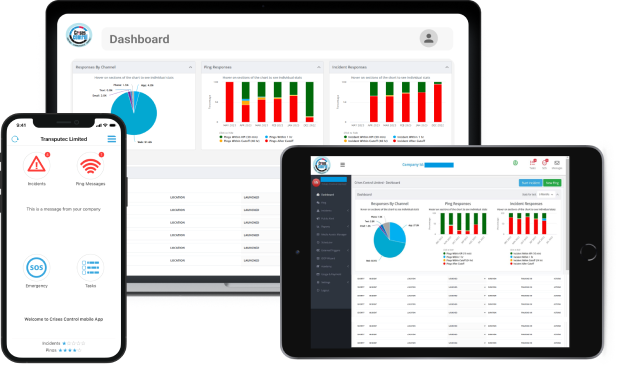Written by Anneri Fourie | Crises Control Executive
When Everything Stops, What Gets You Back on Track?
Most organisations don’t think about what happens when systems fail—until it’s too late.
A cyberattack locks down your network. A power cut wipes out access to your servers. A flood or fire closes your main office. These things aren’t hypothetical—they happen, and often without warning. The real test is how quickly you can get everything working again. That’s where a disaster recovery platform becomes essential.
The problem is simple: when disaster strikes, most businesses aren’t ready to respond. Plans are out of date. Key people aren’t available. Communication breaks down. The cost of downtime—lost revenue, damaged reputation, and unhappy customers—piles up by the minute.
The solution? A structured, easy-to-use system that helps you act quickly, recover fast, and keep your business running. In other words, a disaster recovery platform that brings together people, processes, and technology to keep you in control.
Let’s explore what that actually means—and how Crises Control can help.
What Is a Disaster Recovery Platform?
A disaster recovery platform is a set of tools that helps you respond to and recover from disruption—quickly, safely, and with as little damage as possible.
It’s not just about backing up data. A true disaster recovery platform helps you:
- Communicate with your teams and stakeholders when systems are down.
- Follow a step-by-step plan that everyone understands.
- Monitor progress in real time and adjust as needed.
- Prove what you’ve done for audits or compliance.
It’s like having a clear, shared instruction manual for what to do when things go wrong, and the tools to carry it out, even when the pressure is on.
Crises Control gives you exactly that. It combines mass communication, incident management, and recovery planning into one platform. Whether it’s a tech failure, a security breach, or a physical emergency, Crises Control helps you respond faster and smarter.
Business Continuity and Disaster Recovery: What’s the Difference?
You might hear the terms business continuity and disaster recovery used together, and that’s because they’re closely connected, but not the same.
Business continuity is about keeping your business running during a disruption. That includes people, premises, suppliers, and communication.
Disaster recovery focuses on restoring IT systems, data, and infrastructure after an incident.
Together, they form the backbone of your organisation’s resilience. And a strong disaster recovery platform supports both sides, helping you stay operational during the crisis and recover fully after it.
Why Most Disaster Recovery Plans Fail
Many businesses have a disaster recovery plan sitting in a folder or shared drive. But when something goes wrong, that plan often fails. Why?
- It’s out of date. People leave, systems change, and plans don’t get updated.
- It’s not tested. No one has run through the steps in real time.
- It’s not accessible. When systems are down, how do you find the plan?
- It’s unclear. The plan is full of jargon and assumes everyone knows what to do.
That’s where a platform like Crises Control makes the difference. It doesn’t just store the plan, it activates it. It guides your teams step by step, sends alerts, assigns tasks, and tracks progress. And because it’s cloud-based, it works even if your office systems are offline.
How to Implement a Disaster Recovery Strategy That Works
You don’t need to be a large organisation with a big IT team to build a working disaster recovery strategy. Here’s a straightforward way to start.
1. Understand What You Need to Protect
Start with a risk assessment. What would happen if your email went down? What if your payment system stopped working? Map out your critical systems and business functions. Think in terms of:
- How long could this be down before it causes real harm? (Recovery Time Objective)
- How much data could we afford to lose? (Recovery Point Objective)
2. Set Up a Clear Recovery Plan
Your recovery plan should include:
- A list of key contacts.
- Step-by-step actions for different types of incidents.
- Communication templates.
- Escalation procedures.
Crises Control helps build these into digital workflows that launch automatically when triggered.
3. Choose the Right Tools
A disaster recovery platform should:
- Be easy to use under pressure.
- Work across devices.
- Send alerts and updates.
- Integrate with your existing systems.
Crises Control offers all of these, plus a mobile app that lets you manage incidents on the go.
4. Test and Improve
Once your plan is in place, test it. Run a simulation every few months. Review what went well and what didn’t. Crises Control makes testing easy with scheduled drills, reports, and live dashboards.
Key Features to Look for in a Disaster Recovery Platform
Not all platforms are created equal. Here’s what to look for when choosing a disaster recovery solution:
Built-In Communication Tools
Can you alert your whole team if your email is down? Crises Control offers multi-channel communication—email, SMS, voice calls, and app push notifications—so your message gets through, no matter what.
Real-Time Dashboards and Tracking
You need to see what’s happening as it unfolds. Our dashboard shows task progress, team responses, and incident timelines in real time.
Pre-Built Response Plans
Create digital workflows for specific incidents, like a ransomware attack or server failure, so you don’t have to make decisions under pressure.
Audit Trails and Reporting
Track every step of your response for compliance or post-incident reviews. Easily export reports to share with auditors or stakeholders.
Mobile-First Access
When you’re away from your desk, you still need control. Crises Control’s app lets you launch plans, send alerts, and check responses from your phone or tablet.
How Crises Control Helps You Take Control
Crises Control was built to solve a real problem: businesses struggling to respond effectively when things go wrong. Our platform is used by public services, global companies, schools, and manufacturers—organisations that can’t afford to be offline.
Here’s how we help:
- Speed: Cut response times from hours to minutes.
- Clarity: Get everyone on the same page quickly.
- Confidence: Know your plans will work when they’re needed.
A real example: One of our clients, a logistics firm, faced a cyberattack that knocked out their systems. With Crises Control, they activated their recovery plan, notified their teams, and began restoring services—within 15 minutes. Without the platform, it would have taken hours just to organise a response.
Why You Shouldn’t Wait Until It’s Too Late
Many businesses only take disaster recovery seriously after an incident. By then, the damage is done.
Building resilience doesn’t have to be complicated or expensive. With the right platform, you can prepare properly, act quickly, and recover fully, without losing your grip.
And you don’t have to do it alone. Crises Control works with you to set up everything, from building your plans to running training sessions. We’re here to help you take back control when it matters most.
Let’s Make Sure Your Business Is Ready
A disaster recovery platform isn’t just a nice-to-have. It’s the safety net that helps you stay open, stay safe, and stay in business, whatever happens.
Book a free demo with Crises Control today to see how we can help you build a practical, powerful disaster recovery strategy that fits your organisation.
Request a FREE Demo

